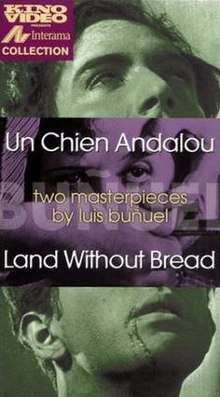Land Without Bread
Las Hurdes: Tierra Sin Pan (English: Land Without Bread or Unpromised Land) is a 1933 pseudo-documentary (ethnofiction) directed by Luis Buñuel and co-produced by Buñuel and Ramón Acin. The narration was written by Buñuel, Rafael Sánchez Ventura, and Pierre Unik, with cinematography by Eli Lotar.
| Las Hurdes | |
|---|---|
 | |
| Directed by | Luis Buñuel |
| Produced by | Ramón Acín Luis Buñuel |
| Written by | Luis Buñuel Rafael Sánchez Ventura Pierre Unik |
| Starring | Abel Jacquin Alexandre O'Neill |
| Music by | Darius Milhaud Johannes Brahms |
| Cinematography | Eli Lotar |
| Edited by | Luis Buñuel |
Release date | December 1933 |
Running time | 27 mins |
| Country | Spain |
| Language | French |
Synopsis
The film focuses on the Las Hurdes region of Spain, the mountainous area around the town of La Alberca, and the intense poverty of its occupants, who were so backwards and isolated that bread was unknown. A main source of income for them was taking in orphan children, for whom they received a government subsidy. Buñuel, who made the film after reading the ethnographic study Las Jurdes: étude de géographie humaine (1927) by Maurice Legendre, took a Surrealist approach to the notion of the anthropological expedition. The result was a travelogue in which the narrator’s extreme (indeed, exaggerated) descriptions of human misery of Las Hurdes contrasts with his flat and uninterested manner.
Cast
- Abel Jacquin (voice)
- Alexandre O'Neill (voice, dubbed version)
Production
Buñuel claimed: "I was able to film Las Hurdes thanks to Ramon Acin, an anarchist from Huesca,...who one day at a cafe in Zaragoza told me, 'Luis, if I ever won the lottery, I would put up the money for you to make a film.' He won a hundred thousand pesetas...and gave me twenty thousand to make the film. With four thousand I bought a Fiat; Pierre Unik came, under contract from Vogue to write an article; and Eli Lotar arrived with a camera loaned by Marc Allégret."[1]
The movie is a pseudo-documentary, parodying the exaggerated documentaries of travelers across the Sahara being filmed at the same time.[2] One of Buñuel's points is that there are plenty of terrible subjects for a documentary right in Spain.
The film was originally silent, though Buñuel himself narrated when it was first shown.[3] A French narration by actor Abel Jacquin was added in Paris in 1935. Buñuel used extracts of Johannes Brahms' Symphony No. 4 for the music.
Buñuel slaughtered at least two animals to make Las Hurdes. One Hurdano claimed that he arranged for an ailing donkey to be covered with honey so he could film it being stung to death by bees. Similarly, his crew shot a mountain goat that subsequently fell from a cliff for another sequence.[4]
Premiere and censorship
The premiere took place in December 1932 at Madrid's Palacio de la Prensa.[5] The entire intellectual cream of the Spanish capital was invited to a semi-private show.[5] The screening of the film in its first, still silent version was accompanied by music played from the turntable and the narrator's commentary personally read by Buñuel himself.[5] During the premiere show there was a schism between the director and Gregorio Marañón,[5] a former assistant to King Alfonso XIII of Spain during his trip to the Las Hurdes region in 1922 and the former director of the Royal Patronage (Spanish Patronato Real), an organization formed shortly after the trip to improving the situation of the inhabitants of the region.[6]
Land Without Bread provoked such an uproar in Spain that conservative forces banned the distribution of the image throughout the country.[7][5][8] The official reason for the censorship record was "defamation of the good name of the Spanish people."[6] It was banned[4] from 1933 to 1936.
Reception
Critical reception for Land Without Bread has been mostly positive. Ed Gonzalez from Slant Magazine awarded the film 4 out of 4 stars, writing, "Las Hurdes becomes a frightening call to arms, a fabulous open text that resists simple readings and questions humanity’s notion of progress."[9] Jeffrey Ruoff called it a "revolutionary film."[10]
Buñuel in the Labyrinth of the Turtles is a 2018 Spanish-Dutch animated film based on the graphic novel Buñuel en el laberinto de las tortugas by Fermín Solís. It covers how Buñuel and his crew filmed at Las Hurdes.
References
- Jose De La Colina, Tomas Perez Turrent.Objects of Desire - Conversations with Luis Buñuel.Trans. Paul Lenti.Marsilio Publishers, 1992. ISBN 0-941419-68-1.
- Ruoff, Jeffrey. An Ethnographic Surrealist Film: Luis Buñuel's Land Without Bread. Visual Anthropology Review 14, no. 1 (Spring/Summer 1998), 45-57
- Luis Buñuel. My Last Breath. Trans. Abigail Israel. Fontana, 1987. ISBN 9780006540885.
- McNab, Geoffrey (8 September 2000). "Bunuel and the land that never was". The Guardian. London. Retrieved 30 October 2011.
- Javier Herrera (2014-04-22). Estudios sobre Las Hurdes de Buñuel: Evidencia fílmica, estética y recepción (in Spanish). Editorial Renacimiento. ISBN 9788484729518. Retrieved 2016-06-20.
- Iker Jiménez Elizari (2006-04-06). El paraíso maldito (in Spanish). EDAF. ISBN 9788441417724. Retrieved 2016-06-20.
- Jeffrey Ruoff (1998-03-01). "An Ethnographic Surrealist Film: Luisbuñuel's land Without Bread". Visual Anthropology Review. 14 (1): 45–57. doi:10.1525/var.1998.14.1.45. ISSN 1548-7458.
- Geoffrey McNab (2000-09-09). "Bunuel and the land that never was". the Guardian. Retrieved 2016-06-20.
- Gonzalez, Ed. "Land Without Bread". Slant Magazine.com. Ed Gonzalez. Retrieved 6 December 2018.
- Ruoff, Jeffrey. An Ethnographic Surrealist Film: Luis Buñuel's Land Without Bread. Visual Anthropology Review 14, no. 1 (Spring/Summer 1998), 45-57